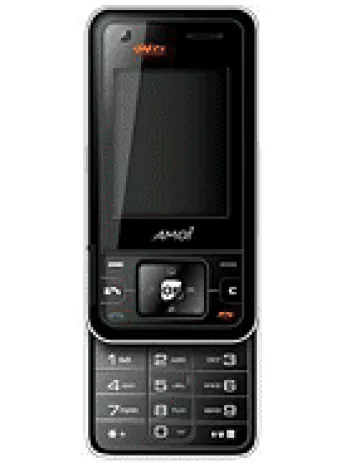
Overview
The Amoi F620 is a feature phone that represents a time when cell phones were primarily used for calling and messaging rather than managing our digital lives. Released in the second quarter of 2006, this device catered to the fundamental communication needs while adding a touch of modern technology available at that time. Its compact nature, simplistic design, and basic functionalities made it popular among users who preferred traditional phones.
Design and Build
The Amoi F620's dimensions are 87 x 46 x 23 mm, and it weighs just 80 grams, making it lightweight and highly portable. Its compact size allowed users to easily slip it into their pockets or bags. The device was built using materials common to that era's feature phones, providing adequate durability for daily usage. The Amoi F620 was sold in appealing colors such as Silver Pink and Silver Blue, giving it a stylish flair despite its simplicity.
Display
Equipped with a 1.5-inch TFT display that could render 256K colors, the screen of the Amoi F620 was modest by today's standards. The 128 x 128 pixels resolution offered a decent display quality for its size, with a pixel density of approximately 121 ppi. The screen, which accounted for around 18.1% of the phone's body, was adequate for displaying basic graphics and text.
Camera
The Amoi F620 included a VGA camera, which is rated at 0.3 MP. Although it was not designed for professional photography, it provided users the ability to capture simple images. The absence of video capabilities might seem like a limitation today, but during its time, the emphasis was more on sturdiness and consistency in making phone calls and less on multimedia features.
Storage and Memory
In terms of memory, the Amoi F620 came with 128MB of internal storage, which was ample for storing contacts, messages, and a few ringtones. It could store up to 500 phonebook entries, alongside maintaining records for 20 dialed, 20 received, and 20 missed calls. However, it lacked a memory card slot, meaning users had to manage within the given internal memory capacity, which was common for feature phones during that period.
Battery Life
The Amoi F620 was powered by a removable Li-Ion 720 mAh battery. The battery life was quite practical, offering up to 100 hours of standby time and up to 3 hours of talk time. Its battery capabilities were considered satisfactory, ensuring users could stay connected without frequent recharges.
Connectivity
The connectivity features of the Amoi F620 were fairly basic, supporting only GSM technology with GPRS Class 10 for data. It operated on 2G bands (GSM 900 / 1800 / 1900), adhering to the standard cellular technology in use at the time. The phone did not support modern data connectivity options like Bluetooth or Wi-Fi, nor could it access EDGE networks. Nevertheless, it came equipped with a miniUSB 1.1 port, allowing for wired data exchange and charging.
Sound and User Interface
Although the Amoi F620 lacked a loudspeaker and a 3.5mm audio jack, it compensated with a variety of alert types including vibration and downloadable polyphonic, MP3, and MIDI ringtones. The absence of a loudspeaker may have limited its utility as a hands-free speakerphone, but it was not uncommon for feature phones of the time. The user interface was straightforward and user-friendly, suitable for users primarily interested in basic functionality.
Additional Features
The Amoi F620 was designed with various messaging options, supporting both SMS and MMS. It featured a WAP 2.0 browser for basic internet browsing, which while limited by modern standards, was a convenient feature for accessing simple web pages at the time. The phone also came with pre-installed games, providing light entertainment to users. However, it did not support Java applications, a feature that was gaining popularity in mobile phones around that time.
Conclusion
The Amoi F620, with its basic features and stylish design, was a reflection of the transitional period of mobile technology. It appealed to users who needed communication tools without the complexity of modern smartphones. As technology progressed, the minimalistic yet functional nature of devices like the Amoi F620 highlighted a significant phase in the evolution of mobile telephony.
Key Features of Amoi F620
- Lightweight design: Weighs only 80 g (2.82 oz)
- Compact dimensions: 87 x 46 x 23 mm
- Bright TFT display with 256K colors
- Removable Li-Ion 720 mAh battery for easy replacement
- 500-entry phonebook capacity
- VGA main camera
- Support for SMS and MMS messaging
- MiniUSB 1.1 connectivity
- Available in stylish Silver pink and Silver blue colors
Amoi F620 Main Disadvantages
- Only supports GSM technology; no support for 3G or 4G.
- Discontinued model; no longer available for purchase.
- Very small display screen of 1.5 inches with low resolution (128 x 128 pixels).
- No EDGE support for faster data connectivity.
- Missing features like Bluetooth, WLAN, and GPS.
- No expandable memory; lacks a card slot.
- Basic VGA camera with no video recording capability.
- No front-facing selfie camera.
- Absence of a loudspeaker.
- No 3.5mm headphone jack for audio.
- No radio functionality.
- Very limited internal memory of 128MB.
- Java applications not supported.
- Short battery life with a talk time of only up to 3 hours.
View Also
More Phones
All Rights Reserved +13676 Phones © Mobilawy 2025

























